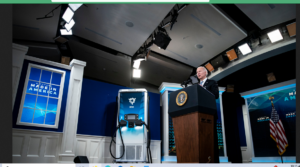Congress Spent $7.5 Billion on E.V. Chargers. After 2 Years, None Are Built.
More than $2 billion has been distributed, but only two states have even broken ground and most states haven’t even submitted proposals.
President Joe Biden has made a transition to electric vehicles (E.V.s) a key part of his presidency, spending billions of dollars both to help companies build them and to help customers afford them.
The 2021 Infrastructure Investment and Jobs Act included $7.5 billion to build 500,000 public charging stations across the country. Under the program, states can qualify for as much as 80 percent of the cost to build chargers and bring them online. But as Politico reported this week, not a single charger funded by the program is yet operational.
It’s the latest setback as Biden attempts to change consumer preference by force rather than allowing the free market to innovate its way there.
Earlier this year, the Environmental Protection Agency mandated that by 2030, half of all vehicles sold in the U.S. must be electric. This will require an enormous ramp-up in resources, especially around charging infrastructure. As Politico notes, “consumer demand for electric vehicles is rising in the United States, necessitating six times as many chargers on its roads by the end of the decade, according to federal estimates.”
Other estimates are even more dire: In January, Stephanie Brinley at S&P Global Mobility wrote that “even when home-charging is taken into account, to properly match forecasted sales demand, the United States will need to see the number of EV chargers quadruple between 2022 and 2025, and grow more than eight-fold by 2030.” As of this writing, there are just under 158,000 public chargers, meaning there may need to be more than 1 million to support the Biden administration’s timeline.
The federal program is off to a slow start: Politico reports that while more than $2 billion has been given out, only two states—Ohio and Pennsylvania—have actually broken ground on chargers, while just six others have awarded contracts. Fewer than half of U.S. states have even submitted a proposal for funds.
What’s the hold-up? “The slow rollout…primarily boils down to the difficulties state agencies and charging companies face in meeting a complex set of contracting requirements and minimum operating standards for the federally-funded chargers, according to interviews with state and EV industry officials,” the article notes.
Even with federal funds, part of the problem may also be cost, because the chargers are quite expensive to build and maintain. The types of chargers mentioned in the law are either Level 2 or Level 3, also known as Direct Current Fast Charging (DCFC). Level 2 chargers use alternating current electricity and take between four and 10 hours to charge an E.V., while DCFCs use direct current and can charge an E.V. in less than an hour.
Any long-term solution would prioritize DCFCs—no road-tripper will want to wait all day for their car to charge when fueling up a gas burner takes minutes. But DCFCs are considerably more expensive to install: A 2019 study by the Department of Energy found that while Level 2 chargers can cost up to $6,500 to install, DCFCs can cost as much as $40,000. Depending on factors like hardware costs, other estimates have put the price between $50,000 and $100,000.
